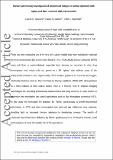Files in this item
Raman spectroscopy investigation of biochemical changes in tumor spheroids with aging and after treatment with staurosporine
Item metadata
| dc.contributor.author | Jamieson, Lauren E. | |
| dc.contributor.author | Harrison, David J. | |
| dc.contributor.author | Campbell, Colin J. | |
| dc.date.accessioned | 2020-01-09T00:37:42Z | |
| dc.date.available | 2020-01-09T00:37:42Z | |
| dc.date.issued | 2019-05 | |
| dc.identifier | 256025534 | |
| dc.identifier | 7a9f8f84-1c09-4d88-899c-89b80cb76d6b | |
| dc.identifier | 85059695843 | |
| dc.identifier | 000467052400004 | |
| dc.identifier.citation | Jamieson , L E , Harrison , D J & Campbell , C J 2019 , ' Raman spectroscopy investigation of biochemical changes in tumor spheroids with aging and after treatment with staurosporine ' , Journal of Biophotonics , vol. 12 , no. 5 , e201800201 . https://doi.org/10.1002/jbio.201800201 | en |
| dc.identifier.issn | 1864-063X | |
| dc.identifier.other | RIS: urn:2BD1F32D1DD4941682FA6EC66839FA8C | |
| dc.identifier.other | ORCID: /0000-0001-9041-9988/work/64034214 | |
| dc.identifier.uri | https://hdl.handle.net/10023/19251 | |
| dc.description.abstract | There has been increasing use of in vitro cell culture models that more realistically replicate the three dimensional (3D) environment found in vivo. Multicellular tumour spheroids (MTS) using cell lines or patient-derived organoids have become an important in vitro drug development tool, where cells are grown in a 3D 'sphere' that exhibits many of the characteristics found in vivo. Significantly, MTS develop gradients in nutrients and oxygen, commonly found in tumours, that contribute to therapy resistance. While MTS show promise as a more realistic in vitro culture model, there is a massive need to improve imaging technologies for assessing biochemical characteristics and drug response in such models to maximize their translation into useful applications such as high throughput screening (HTS). In this study we investigate the potential for Raman spectroscopy to unveil biochemical information in MTS and have investigated how spheroid age influences drug response, shedding light on increased therapy resistance in developing tumours. The wealth of molecular level information delivered by Raman spectroscopy in a noninvasive manner, could aid translation of these 3D models into HTS applications. | |
| dc.format.extent | 2046291 | |
| dc.language.iso | eng | |
| dc.relation.ispartof | Journal of Biophotonics | en |
| dc.subject | Multicellular tumour spheroids | en |
| dc.subject | Raman | en |
| dc.subject | Cancer | en |
| dc.subject | Drug screening | en |
| dc.subject | RC0254 Neoplasms. Tumors. Oncology (including Cancer) | en |
| dc.subject | NDAS | en |
| dc.subject | SDG 3 - Good Health and Well-being | en |
| dc.subject.lcc | RC0254 | en |
| dc.title | Raman spectroscopy investigation of biochemical changes in tumor spheroids with aging and after treatment with staurosporine | en |
| dc.type | Journal article | en |
| dc.contributor.institution | University of St Andrews. School of Medicine | en |
| dc.contributor.institution | University of St Andrews. Cellular Medicine Division | en |
| dc.contributor.institution | University of St Andrews. Sir James Mackenzie Institute for Early Diagnosis | en |
| dc.identifier.doi | 10.1002/jbio.201800201 | |
| dc.description.status | Peer reviewed | en |
| dc.date.embargoedUntil | 2020-01-09 |
This item appears in the following Collection(s)
Items in the St Andrews Research Repository are protected by copyright, with all rights reserved, unless otherwise indicated.

